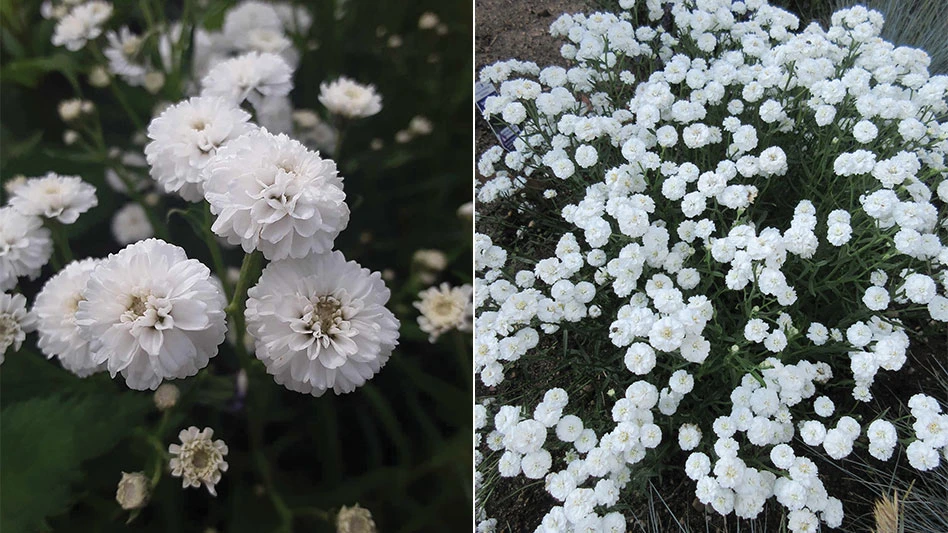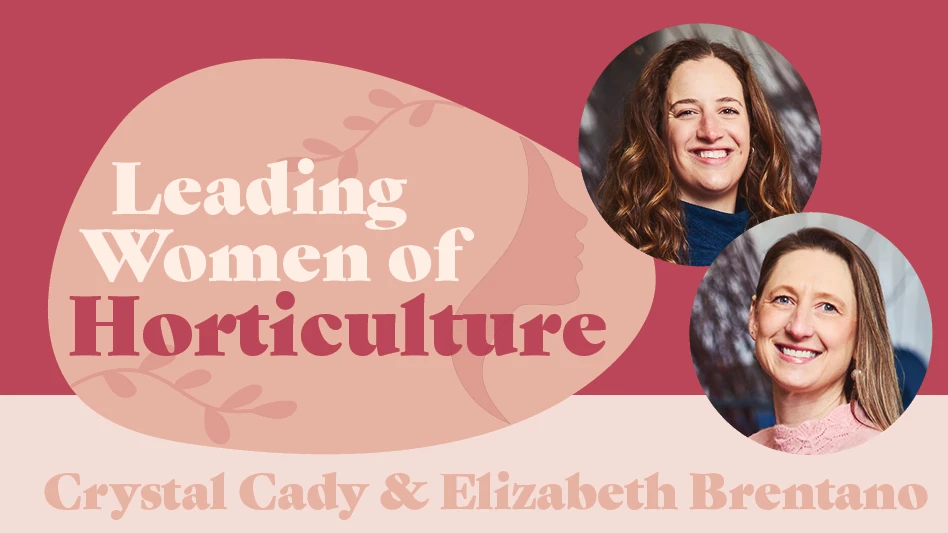
_fmt.png)
About 35 years ago, I penned a brief article on Baptisia cutting propagation for Nursery Manager, now Nursery Management. I grew seedlings of Baptisia australis, false blue indigo, in our first Georgia garden and noticed variation in intensity of blue flower color. I was able to root the selections and add them to the garden. More on seed and cutting propagation later. At that time, I thought Baptisia might be a worthy genus for improvement and a graduate student started the project, but the hand pollinations were not successful. Unfortunately, I did not realize the impact bees have on successful Baptisia pollen transfer. Breeding cages, isolation breeding (two or more different plants removed from others), or old fashioned open-pollination would have succeeded. Years of observation confirmed the variation in traits among seedlings, regardless of breeding methodology.
Baptisia have always been part of our personal gardens and are easy to grow. I observed them from Minnesota to Maine and south to Georgia, thriving with neglect. They have prospered and persisted in the Georgia silty clay loam as long as sited in full sun. Dr. David Creech, director at the Mast Arboretum at Stephen F. Austin State University in Nacogdoches, Texas, mentioned Baptisia are stellar performers in the garden. They fix atmospheric nitrogen similar to other legumes and thus prosper with less inputs than many perennials. Through the 12-years in our new home and garden, deer have been a constant nemesis. Baptisia are deer and rabbit resistant. The only insect I battle is a brown moth (Genista caterpillar, Uresiphita reversalis) whose larvae web and eat the foliage and may strip a plant clean. They emerge in July and can be controlled by an insecticide like Sevin (Bt was recommended) or remove the infected parts and destroy. From year-to-year, their presence is variable — heavy in 2020, scarce in 2021. Even when stripping the plants of foliage, I have not noticed reduced flowering the following spring.
There are approximately 20 species of Baptisia native to the United States. Taxonomy is muddled and Turner [Phytologia 88(3): 253-268. Overview of the genus Baptisia (2006)] listed 17 species with descriptions and distribution maps. A review of the maps showed at least one species in every state east of the Mississippi and several species in contiguous western states. GRIN (Germplasm Resources Information Network) lists 18 legitimate species, two hybrid species, and five varieties.
Habitat in the wild is described as grassy, open areas and under light shade. Most garden types range from 2 to 4 feet in height and width in foliage, the inflorescence rising above the foliage 1 to 2 feet. I have a yellow-flowered seedling that is over 6 feet high when in flower. Foliage of the species and hybrids is composed of three leaflets, green to blue-green, persisting honorably until frost, then turning blackish brown. Although herbaceous, the summer foliage presents the plant as a deciduous shrub. Flowers are borne in elongated racemes 1 to 2 feet high, followed when pollinated, by inflated pods with small, brown, bean-shaped seeds. Not all Baptisia develop fruits, especially the yellow-flowered hybrids. In early April in the Dirr garden, the emerging foliage reminds of asparagus, often with a glaucous tinge, soon maturing and carrying the showy flowers, opening from base to apex, in late April into mid-May. Colors range from white, blue/purple, yellow, pink/rose, maroon, chocolate, brown and bicolor combinations. Flowers open one color, often aging to a different shade. After flowering, plants can be reduced in height by pruning 50-75% into bare stems. I did this with a splaying ‘Screamin’ Yellow’ in 2021 and six weeks later it was covered with new shoots. I read where the plants can be cut to ground level and will regenerate. Have yet to attempt this.

A Baptisia epiphany occurred when Bonnie and I moved into the new home and garden in 2009. I knew of the breeding work of Tony Avent of Plant Delights, Hans Hansen of Walters Gardens, Dr. Jim Ault from the Chicago Botanic Garden, the North Carolina Botanical Garden (‘Carolina Moonlight’), Niche Gardens (‘Purple Smoke’) and others. Soon there were too many cultivars to count and from 2012 to 2015, Mt. Cuba Center evaluated 46 selections representing 11 species. The results are available online at mtcubacenter.org/trials/baptisia. Top rated performers were ‘Screamin’ Yellow’, ‘Lemon Meringue’, ‘Ivory Towers’, ‘Purple Smoke’, ‘Cherries Jubilee’, ‘Sunny Morning’, ‘Blueberry Sundae’, ‘Dutch Chocolate’, and ‘Crème de Menthe’. Since this evaluation there have been more introductions. Dr. Armitage’s 2020 edition of Herbaceous Perennial Plants describes ~35 cultivars in detail. Proven Winners has taken the new introductions (primarily those from Hansen) and placed them in the Decadence series. Remarkably, a 2- to 3-stemmed plant sells for $15 to $25, often with only a single inflorescence. Patience for greatness is necessary with Baptisia.
A fair question to ponder is…What’s next? I hopped on the cultivar train and purchased via mail order and at retail ~10 cultivars, producing seedlings from most. Baptisia alba (first to flower in garden, white flowers, purple stems), ‘Twilight Prairie Blues’, ‘Carolina Moonlight’, ‘Lemon Meringue’ and ‘Brownie Points’ produced the most variations. In fact, from seedling populations of B. alba and ‘Twilight Prairie Blues’, yellow foliage types emerged. Surprisingly, they are vigorous and the yellow foliage color persists into fall, some seedlings brighter than others. Every yellow foliage seedling though 2020 produced only yellow flowers. In 2021, two yellow seedlings had blue flowers, one indigo blue. Another pretty seedling phenomenon is the dusky violet to purple stems (somewhat evident on foliage) on white, yellow, and deep indigo-flowered seedling selections. I named one ‘Violet Haze’. I did not “see” (envision) my backyard efforts as commercial, simply the joy of gardening and, with the plethora of cultivars available, who but me cares about “new.”
Well, Premier Introductions, Inc. (PII) initiated the new breeding adventure on January 1, 2020. Baptisia seeds of cultivars mentioned in the previous paragraph collected from the Dirr garden were sown in January-February 2020, transplanted to cells about six weeks later, then out-planted to the field in June. Most flowered late April to mid-May 2021. Fourteen selections were made and cuttings of all were rooted (procedure described below). The most promising were transplanted to 1-gallon containers on July 8. 2021. The indigo blue/yellow foliage selection, the most prized/unique, is vigorous and the foliage color persists in the heat. PII learned from Tom Demaline at Willoway Nursery and Mark Sellew at Prides Corner Farm that for best survival of rooted cuttings, bury at least one node. In the past, I lost as many as one-half of the rooted cuttings of a selection after transplanting. With transplanted seedlings there are essentially no losses.

Seeds
Collection, cleaning, storage: Seeds are collected in June-July (Athens) when pods are crispy brown/black. I place pods in a 5-gallon bucket, crush them with a rubber mallet, sieve through a strainer with 3/8-inch holes, store in glass jars at 41°F. Dry seeds can be stored for years and maintain high viability. If moist/wet in storage, the seeds germinate in the cold.
Sowing: Before sowing, seeds are steeped in hot water for approximately 24 hours. Seeds have a hard seed coat of variable thickness. The soaking facilitates water imbibition into the seed and initiates the germination process. Only seeds that sink are used. Seeds can be sown in a well- drained germination medium. At PII, Sungro’s Horticulture Propagation Mix is used with outstanding results. It contains 75-85% Canadian peat, perlite, dolomitic lime and I believe a wetting agent. Seeds are covered with ¼-inch to ½-inch of the media and watered. This media is used for more than 90% of our seed work.
Germination: Seeds germinate in 10 to 21 days and are transplanted to cells when about 2 inches high. Roots of seedlings are long and stringy, so a deep hole is punched in the media. Seedlings are lightly fertilized once per week with 100 ppm N from Miracle-Gro. Seeds of eight Baptisia taxa sown on July 23, 2021, produced transplantable seedlings by August 20, 2021.
Transplanting to field or containers: The sooner the liners/seedlings are in the container medium or soil, the faster to flower. Typically, it takes two to three years to build a strong root system. Based on PII’s 2020-21 field success, 15 months from seed sowing to flowering closed the loop. The field-grown seedlings were not fertilized.
_fmt.png)
Cuttings
Cuttings are collected in the field in June, July and August and from previously rooted cuttings in the greenhouse. Single-stemmed and multiple branched shoots are taken, striped of lower leaves, treated with Clonex or 0.15% KIBA, placed in bark/perlite/peat medium under mist. Cuttings root in a month, are removed, lightly fertilized and then transplanted to containers or the field about one month after removal from mist.
Epilogue
Bonnie and I developed a pollinator garden five years ago. Any plant that remotely interested an insect was included. Amsonia, Asclepias, Buddleia, and Baptisia were planted by the hundreds. In spring, 2021, the garden had “filled in” to the delight of the insects and gardeners. The Baptisia (all seedlings) were spectacular. I believe there are opportunities to entice/educate gardeners who have little knowledge of the genus. In fact, during a late April tour of our garden, Bonnie overheard a lady tell her friend that those snapdragons are beautiful.

Get curated news on YOUR industry.
Enter your email to receive our newsletters.
Explore the January 2022 Issue
Check out more from this issue and find your next story to read.
Latest from Nursery Management
- Dümmen Orange North America celebrating 25th anniversary in 2025
- Illinois Landscape Contractors Association changes name to Landscape Illinois
- 2025 Proven Winners Horticulture Scholarship applications now open
- ICL’s Gemini Granular herbicide now registered for use in California
- Eurazeo Planetary Boundaries Fund acquires Bioline AgroSciences
- The Leading Women of Horticulture
- Leading Women of Horticulture: Dana Massey, Plantworks Nursery
- Spring Survival Guide







